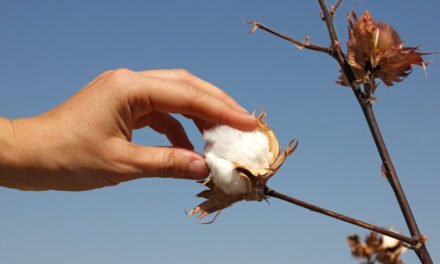 While Western media outlets claim China has been hit by sanctions from the US-led West over so-called “forced labor,” the country is actually working in the opposite direction to break the blockade. China is promoting the development of Xinjiang’s cotton industry, and further opening up to consolidate and enhance its position in global supply chains. A new national-level cotton and yarn trading center in Northwest China’s Xinjiang Uygur Autonomous Region is expected to be a crucial step in this effort.
While Western media outlets claim China has been hit by sanctions from the US-led West over so-called “forced labor,” the country is actually working in the opposite direction to break the blockade. China is promoting the development of Xinjiang’s cotton industry, and further opening up to consolidate and enhance its position in global supply chains. A new national-level cotton and yarn trading center in Northwest China’s Xinjiang Uygur Autonomous Region is expected to be a crucial step in this effort.
The unveiling ceremony of the center was held on Monday in Urumqi, Xinjiang. As reported, Xinjiang will make use of policy dividends offered by its pilot free trade zone and the new trading center as a foundation to strengthen trade with China’s neighboring countries, striving to become a globally influential cotton and yarn production and sales center.
Xinjiang is the largest cotton-producing region in China. A total of 5.98 million tons of cotton were produced nationwide in China in 2022, with more than 90 percent produced in Xinjiang. This reflects the fact that Xinjiang holds a key position in China’s cotton industry chain.
One important reason why Western politicians repeatedly hype the outrageous lie about so-called forced labor in Xinjiang is to suppress Xinjiang’s cotton industry and the broader Chinese textile industry. This is part of their efforts to contain China’s development, particularly its manufacturing sector. We must break down the industry barriers set up by the US-led West.
China’s textile manufacturing industry ranks first in the world in terms of capacity and trade. From 2013 to 2022, China’s total fiber processing volume increased from 48.5 million tons to over 60 million tons, accounting for more than 50 percent of the world’s fiber processing volume, data from the China National Textile and Apparel Council showed.
Textile and clothing exports have remained above $300 billion a year in recent years; however, Western media outlets are keen to hype the transfer of the industry and supply chain from China to other developing countries, claiming that China has lost its comparative advantage in labor-intensive manufacturing, including the textile industry. Their petty trick is crystal clear and should be condemned.
The cost of labor in China has indeed risen and this poses challenges to China’s labor-intensive industries, including textiles. But this is not the whole story.
The new cotton trading center in Xinjiang offers a window to observe the migration of industries within China. While the West is trying to hamstring Chinese economic power, Xinjiang’s economy has been rapidly developing. China’s textile manufacturing and cotton production, which were once concentrated on the coast and in river valleys with easy access to urban markets and ports, are shifting to western inland areas such as Xinjiang. These areas have relatively low labor costs and other industrial advantages.
The new trading center will help Xinjiang establish world-class industry clusters for cotton and textiles, which are among the eight industry clusters emphasized by the local government in Xinjiang.
Along with the trend of industrial transfer, Xinjiang’s opening-up to and cooperation with the outside world have ushered in new opportunities. The Xinjiang Pilot Free Trade Zone (FTZ), the first in China’s northwestern border regions, officially started operations on November 1. The FTZ is expected to make a great contribution to Xinjiang’s integration into the “dual circulation” of domestic and international markets, and play a significant role in building a bridgehead for China’s westward opening-up.
Efforts to push forward a new pattern of all-round opening-up will bring new opportunities to industries, including the textile sector. Although facing challenges, China’s cotton and textile industries will further develop. We must strengthen and consolidate the position of Xinjiang cotton in the global industry chains, so that its development can adapt to the needs of the global market, and deeply embed Xinjiang cotton into global supply chains.





















